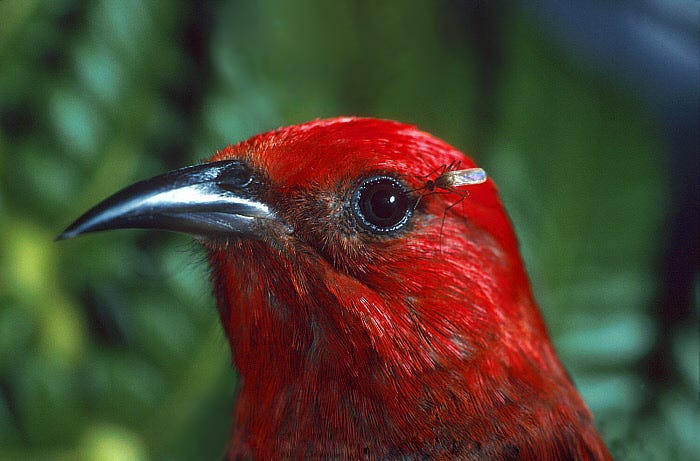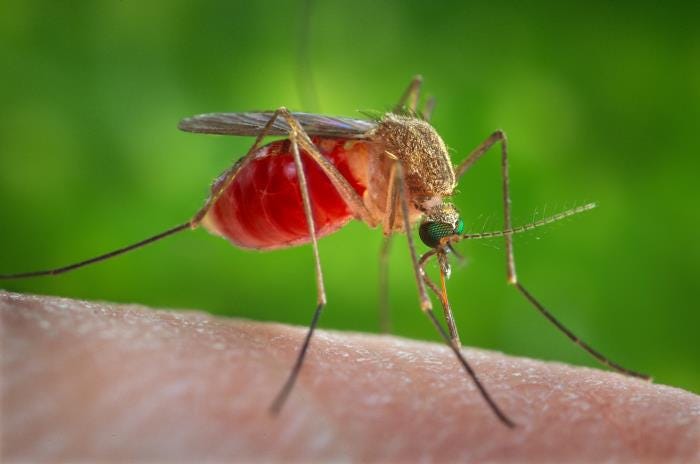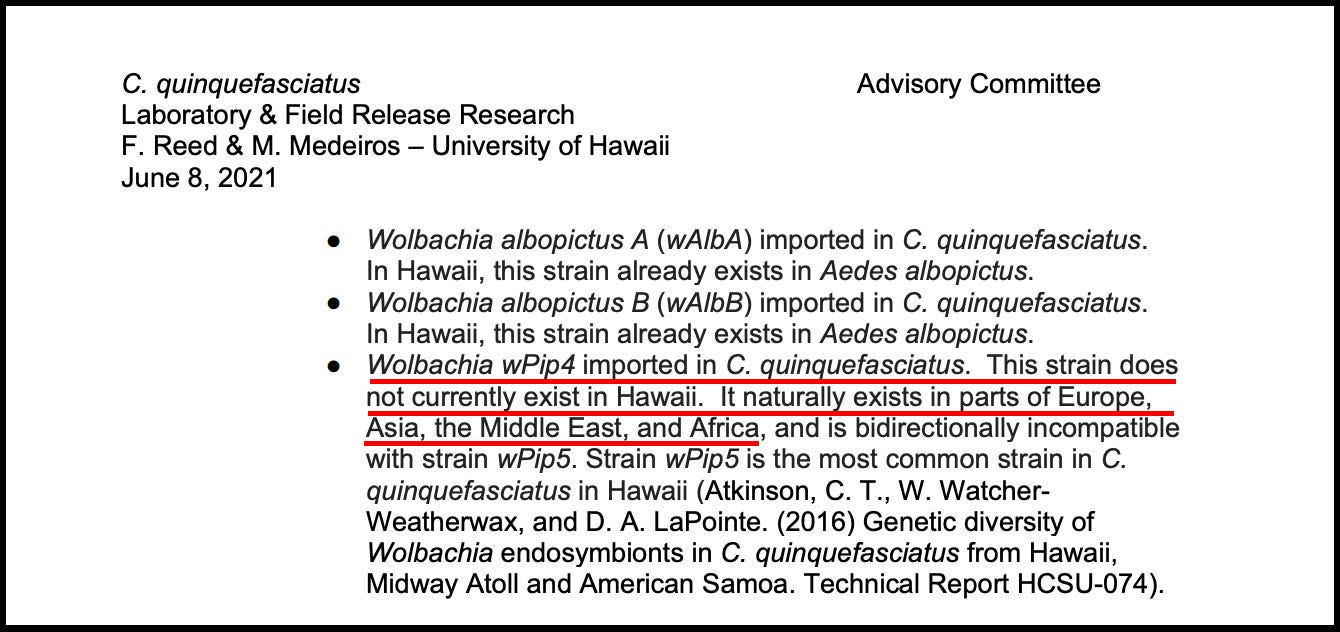Wolbachia Bacteria in Mosquitoes: Misleading Claims by the State
Foreign organisms that play a role in human disease are being released on Maui
For well over a year now, the State of Hawai‘i and its multi-agency partnership Birds, Not Mosquitoes (BNM) have perpetuated several misleading claims about their dangerous release of bacteria-infected mosquitoes on 64,666 acres of East Maui’s natural reserve, watershed, and conservation area. This experimental project has been presented as an effort to save endangered honeycreeper birds from avian malaria, but actually has the potential to cause the extinction of the native forest birds it is meant to save. The southern house mosquitoes used in this phase of the state’s agenda could also impact human health.
Let’s take a look at some of BNM’s statements and explore the topic of Wolbachia bacteria. What do we know about this bacterium that the mosquitoes are being infected with in the lab before import onto the islands and release into our environment?
The final environmental assessment (FEA) for this plan makes the claim that the release of Wolbachia-infected mosquitoes will reduce avian malaria and save Hawai‘i’s forest birds.
“The purpose of the project is to substantially suppress or eliminate non-native mosquitoes in threatened and endangered forest bird habitat on East Maui, thereby reducing the risk of their extinction and contributing to the recovery of these species.”
The reality is that peer-reviewed studies have shown that Wolbachia bacteria can increase pathogen infection in mosquitoes and can cause them to become more capable of transmitting avian malaria and West Nile virus (bird and human).
“However, a worrying trend is emerging whereby Wolbachia infections have been demonstrated to enhance rather than suppress pathogens in some systems. Plasmodium parasites, which are the causal agent of malaria, seem particularly prone to Wolbachia-mediated pathogen enhancement.”
“Contrary to other systems, Wolbachia did not inhibit WNV in this mosquito. Rather, WNV infection rate was significantly higher in Wolbachia-infected mosquitoes compared to controls.” (WNV: West Nile virus)
The agencies involved in this project have not even taken the time to study these potential risks with the specific strains of Wolbachia bacteria used in combination with the southern house mosquitoes being lab-infected for release into our ecosystems. This mosquito plan could further endanger Hawai‘i’s forest bird populations. If the concern is for saving these birds, why haven’t these studies been done prior to rushing this plan forward?
The FEA states that this Wolbachia-infected mosquito technique (“Incompatible Insect Technique” or “IIT”) is safe and effective and has been used successfully around the world:
“This is neither an experiment nor a novel technique being tested in Hawaiʻi.”
This couldn’t be further from the truth. The plan here is entirely experimental and has never been done anywhere in the world before. In addition to Maui being the largest release area of any IIT Wolbachia-infected mosquitoes globally to date (the prior largest being in Texas and Florida), the species of mosquito being used here – the southern house mosquito – has never been lab-infected with Wolbachia bacteria and used for a stand-alone mosquito suppression field release. Further, Wolbachia IIT is not widely used for mosquito suppression globally. The majority of countries using Wolbachia mosquitoes through the World Mosquito Program are using the method of population replacement, not suppression. These are two entirely different techniques. Even the use of these mosquitoes for bird conservation is completely new, as confirmed by the U.S. Department of the Interior (project funders):
“…although used world-wide for human health, Wolbachia IIT is a novel tool for conservation purposes and its degree of efficacy in remote forest landscapes is unknown.”
Birds, Not Mosquitoes has made numerous misleading statements about the mosquitoes and bacteria for this project already existing on the islands. The FEA falsely states:
“The proposed action will not involve introducing any new or foreign organisms to Hawaiʻi”
Actually, the Wolbachia for this project is literally an introduced foreign bacterium. The State of Hawai‘i’s EPA Application for Emergency Exemption for use of the mosquitoes explains that the bacteria will be coming from Malaysia:
“The DQB line of mosquitoes was developed through transfection of Wolbachia pipientis wAlbB isolated from Ae. Albopictus KLP strain mosquitoes originating from Kuala Lumpur, Malaysia into Culex quinquefasciatus Palmyra strain mosquitoes originating from Palmyra Atoll.”
Note: Culex quinquefasciatus is the scientific name for the southern house mosquito. The lab-infected mosquitoes for this plan are labeled “DQB Males” (D: Debug, Q: Culex quinquefasciatus, B: wAlbB Wolbachia strain).
In addition to that, the state’s field release import request lists a strain of bacteria that doesn’t exist in Hawai‘i, wPip4. How that strain is intended to be used is unknown. In 2021, the University of Hawai‘i confirmed that wPip4 is a foreign bacteria:
The risks of these mosquitoes to human health are repeatedly downplayed by agency partners. In actuality, these risks have not even been properly assessed or researched. The FEA states:
“The released mosquitoes pose no risk to human health.”
The potential for the introduced Wolbachia bacteria strain to cause the southern house mosquitoes to become more capable of transmitting West Nile virus to humans has not been studied. This is alarming not only in light of the 2014 peer-reviewed study concluding that the West Nile virus infection rate was significantly higher in Wolbachia-infected mosquitoes compared to controls, but also because the pathogen screenings for the mosquitoes being brought into Hawai‘i are unknown. We submitted a FOIA request to the EPA for documents describing pathogen screenings, but that information has been withheld as confidential.
There are other human diseases that southern house mosquitoes transmit, and Wolbachia bacteria plays a role in one of those diseases – elephantiasis (lymphatic filariasis). According to the CDC:
“Lymphatic filariasis, considered globally as a neglected tropical disease (NTD), is a parasitic disease caused by microscopic, thread-like worms. The adult worms only live in the human lymph system. The lymph system maintains the body’s fluid balance and fights infections. Lymphatic filariasis is spread from person to person by mosquitoes.
People with the disease can suffer from lymphedema and elephantiasis and in men, swelling of the scrotum, called hydrocele. Lymphatic filariasis is a leading cause of permanent disability worldwide. Communities frequently shun and reject women and men disfigured by the disease. Affected people frequently are unable to work because of their disability, and this harms their families and their communities.”
The National Institutes of Health (NIH) documents the role of Wolbachia bacteria in diseases caused by parasitic worms (filarial nematodes), including elephantiasis:
“Wolbachia pipientis is a widespread intracellular bacterial symbiont of arthropods and is common in insects. One of their more exotic and unexpected hosts is the filarial nematodes, notable for the parasites responsible for onchocerciasis (river blindness), lymphatic filariasis (elephantiasis) and dirofilariasis (heartworm).”
While the specific strains of Wolbachia involved in these diseases may be different from those planned for use in BNM’s program, the very fact that the dangerous implications for human disease of Wolbachia bacteria in general have been dismissed by agencies promoting these lab-infected mosquitoes is highly concerning. On top of that, the FEA’s assertion that released mosquitoes pose no risk to human health is based on unsound science. The 2010 article by Popovici et al. cited in the FEA has been discredited by the EPA. The EPA Human Studies Review Board met in 2018 and concluded:
“The Board concluded that the research described in the article by Popovici et al. was not scientifically sound and does not provide reliable data to contribute to a weight of evidence determination for assessment of human health risks due to release of Wolbachia-infected mosquitoes.”
The State of Hawaii and its agency partners have not adequately addressed any of these concerns, nor have they acknowledged peer-reviewed studies and expert opinions regarding the ability of Wolbachia bacteria to live outside of the host in the environment for several months and to transmit horizontally to other insects, including insect vectors of disease. Instead, their FEA presents a false narrative:
“Wolbachia bacteria cannot transfer between animal species or to humans. Similarly, it cannot transfer between male mosquitoes and female mosquitoes; mosquitoes can only inherit Wolbachia from their mother.”
The fact that they would even make this statement is appalling when numerous peer-reviewed studies have documented the spread of the bacteria between insects through mating, shared feeding sites, and serial predation. Why has this not been studied in the mosquitoes being used in this project?
Hawai‘i Unites has been working actively to raise awareness about this dangerous project and the risks involved with bringing these lab-infected mosquitoes and the parasitic Wolbachia bacteria they host onto the islands. We’ve taken the state to court to seek a ruling to require further study and to halt the release of these mosquitoes until the risks to our native birds, wildlife, human health, and environment have been properly researched. We need your help to stop these agencies from unleashing this irreversible and potentially catastrophic experiment on our island home.
Your tax-deductible donation to our organization will help us continue to move our legal case forward. Please join us in challenging this project and demanding that the state stop the release of bacteria-infected mosquitoes in East Maui so that we can set a global precedent for the people’s voice in the decision-making process.
Mahalo,
Tina Lia
Founder
Hawai‘i Unites
HawaiiUnites.org
Hawai‘i Unites is a 501(c)(3) nonprofit organization dedicated to the conservation and protection of our environment and natural resources.










